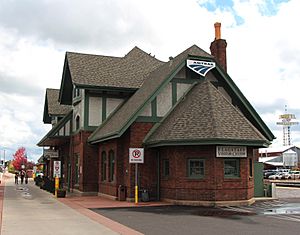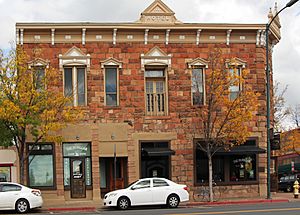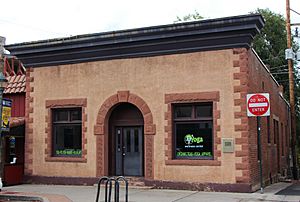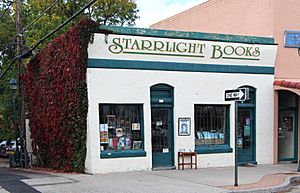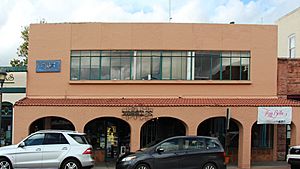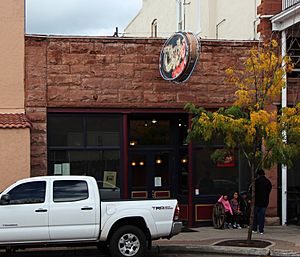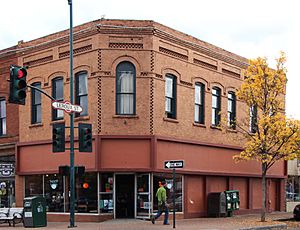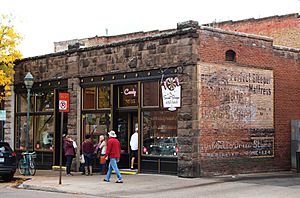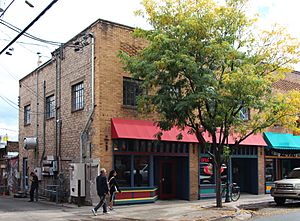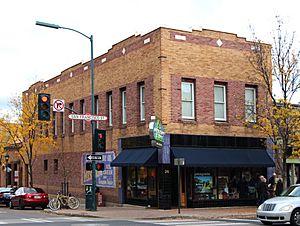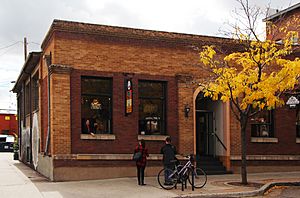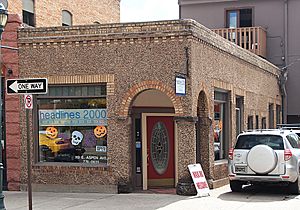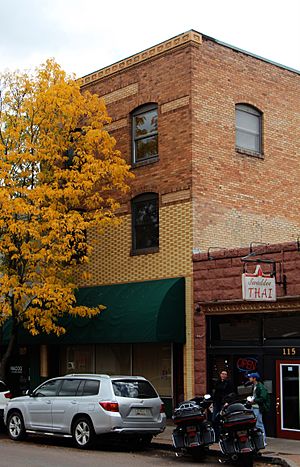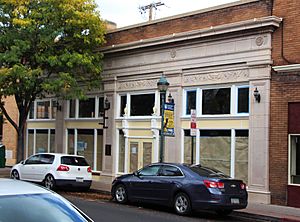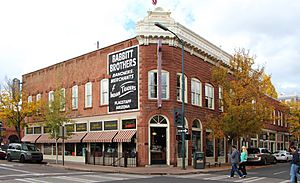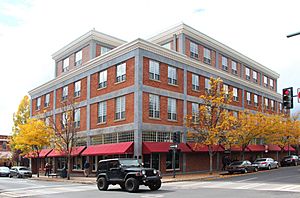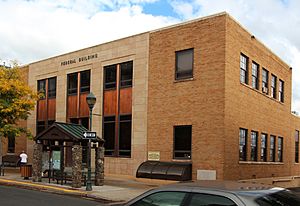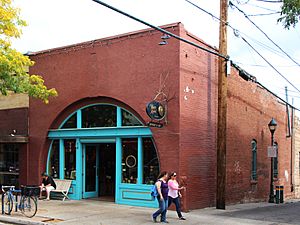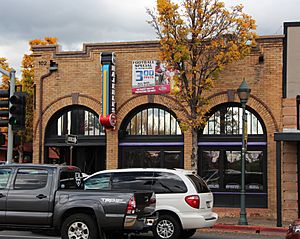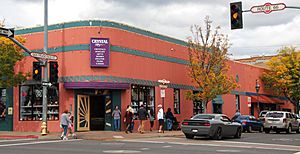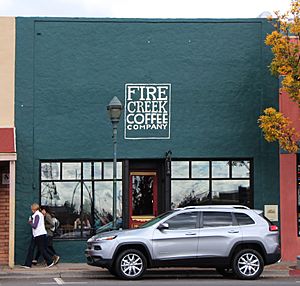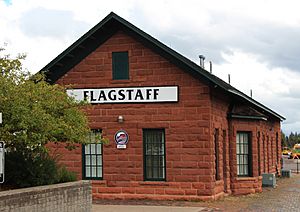Railroad Addition Historic District (Flagstaff, Arizona) facts for kids
|
Railroad Addition Historic District
|
|
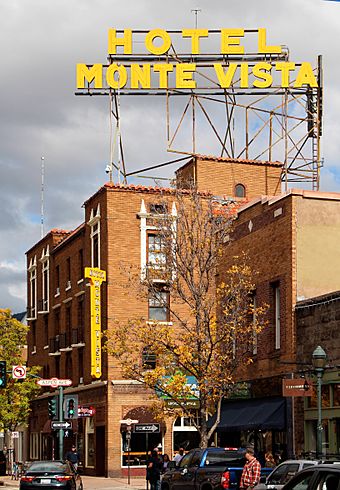
Hotel Monte Vista
|
|
| Lua error in Module:Location_map at line 420: attempt to index field 'wikibase' (a nil value). | |
| Location | Roughly bounded by Santa Fe RR tracks, Agassiz and Beaver Sts., Birch and Aspen Aves., Flagstaff, Arizona |
|---|---|
| Area | 17.8 acres (7.2 ha) |
| Built | 1883 |
| Architect | Underwood, Gilbert Stanley; Et al. |
| Architectural style | Early Commercial, Romanesque, Classical Revival |
| MPS | Flagstaff MRA (AD) |
| NRHP reference No. | 83002989 (original) 86001360 (increase 1) 97001086 (increase 2) |
Quick facts for kids Significant dates |
|
| Added to NRHP | January 18, 1983 |
| Boundary increases | June 17, 1986 September 5, 1997 |
The Flagstaff Railroad Addition Historic District is a super important part of the city's history! It's special because it's connected to the old Atchison, Topeka and Santa Fe Railway and the famous U.S. Route 66. This area shows how Flagstaff grew up around the railroad.
The original part of the district was near the Santa Fe railroad tracks. It was bounded by Agassiz and Beaver Streets, and Birch and Aspen Avenues. Later, the district was made bigger two times. This added nine more buildings along Phoenix Avenue and one building at 122 East Route 66.
Contents
Discovering Flagstaff's Historic Railroad District
Building Flagstaff's Downtown
Early Flagstaff had some really bad fires. One big fire happened in 1897. After that, the city made a rule. All new buildings in the main business area had to be built from strong materials. They had to use brick, stone, or iron to prevent future fires. This is why many old buildings in Flagstaff look so solid.
Famous People Behind the Buildings
Many buildings in the Railroad Addition Historic District are linked to important business people. These people lived in the late 1800s and early 1900s. One famous person was John W. Weatherford. He built the well-known Weatherford Hotel.
The Babbitt brothers were also very important. Their names were David, George, William, and Charles. They owned many buildings in the district. Thomas E. Pollock, Sr. was another key figure. These people helped shape what Flagstaff looks like today.
Explore Historic Buildings!
Here are some of the most interesting buildings in the Railroad Addition Historic District. Each one has a unique story!
| Name | Year Built | Architectural Style | Comments |
| Flagstaff 1926 Depot | 1926 | Revival Tudor | This building was made during the busy 1920s. Today, it's a symbol of Flagstaff. It's now the Amtrak station and Visitor Center. |
| McMillan Building | 1886 | This hotel was built using local stone and bricks. A bank was located on its corner. | |
| Raymond Building | 1911 | Dr. Raymond was one of Flagstaff's first doctors. The building has Moencopi sandstone around its door. | |
| Loy Building | 1897 | Mr. Loy was a lawyer in Flagstaff. | |
| Citizen's Bank Building | 1903 | This building was made from Moencopi sandstone. | |
| Flagstaff Telephone Exchange | 1909 | This was the first big telephone office in Flagstaff. John Weatherford built it. It became a restaurant in 1930. It's also made of Moencopi sandstone. | |
| Weatherford Hotel | First section made 1898 and second section made in 1899 | This hotel has been a main building downtown since 1900. It was built with Moencopi sandstone. | |
| Coalter Building | 1898 | This building was Flagstaff's very first Post Office. | |
| Pollock Building | 1900-1903 | Flagstaff's first library was on the second floor of this building. | |
| Babbitt Building #1 | 1907 | Flagstaff's second Post Office was located here. It was built using tufa stone. | |
| Babbitt Building #2 | 1911 | ||
| Elks Hall | 1899 | The Elks group used the top floor. The first bowling alley in Flagstaff was in the basement! The ground floor was a drug store. | |
| Coconino Sun Building | 1926 | The Sun Newspaper has been Flagstaff's newspaper since 1891. It moved here to make space for the Monte Vista Hotel. | |
| Bikker Building #1 | 1917 | This was first a harness shop. It has an unusual pebble siding added later. | |
| Bikker Building #2 | 1917 | The first J.C. Penny store in Flagstaff was on the first floor. The second floor was an Odd Fellows hall. | |
| Monte Vista Hotel | 1926 | Building this hotel was a huge community effort. In 1926, people raised $200,000 in just 60 days! | |
| Riordan Building | 1917 | Neoclassical | This was Flagstaff's third Post Office. |
| Babbitt Brothers Building | 1888 | This was originally a department store. It has been made bigger many times. It was restored to its original look in 1990. | |
| Babbitt's Garage | 1915 | The Babbitt brothers built this garage for cars. They used reinforced concrete, which was new for the area. | |
| Masonic Temple | 1917 | The upper floor held the temple. The ground floors and basement were rented out. | |
| Federal Building | 1936 | Federal Modern style | This was Flagstaff's fifth Post Office. |
| Hawks Building | 1897 | ||
| Nackard Building | 1922 | This was the location of Flagstaff's fourth Post Office. | |
| Brannen Building #3 | 1887 | This building housed the town's first doctor, D. J. Brannen. He had his office and drug store here. | |
| Brannen Building #5 | 1883 | P.J. Brannen was the first store owner to start a business in Flagstaff. The building burned once but was rebuilt using its original stones. | |
| Vail Building | 1888 | Art Deco | Many of Flagstaff's first businesses were saloons. They served railroad workers. The building was made of brick, but covered in stucco in 1939. |
| Donahue Building | 1888 | This was originally a saloon. It was owned by Sandy Donahue, a very colorful person in Flagstaff. It was built of brick and covered in stucco in the 1930s. | |
| Santa Fe Depot 1889 | 1889 | This was Flagstaff's first train depot. A wooden depot burned down in 1886. This building is made of Moencopi sandstone. |


